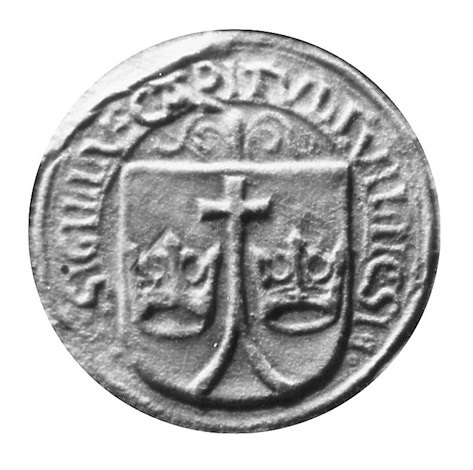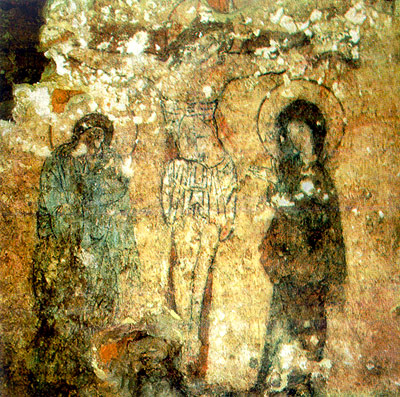|
Belarusian Gothic
Belarusian Gothic () is the architectural style of ecclesiastical buildings and fortified structures of the 15th and 16th centuries in modern Belarus, Lithuania, eastern Poland and western Ukraine. Although these buildings have features typical of Gothic architecture such as lofty towers, flying buttresses, pointed arches and vaulted ceilings, they also contain elements not typically considered Gothic by Central and Western European standards. Terminology The term was introduced by Belorussian historian Mikoła Ščakacichin in his work "Essays from the history of Belarusian art" in 1920s. Initially supported by Belorussian historians, in 1960s-80s it gained recognition amongst some of the Russian and Lithuanian historians. Depending on the area it can also be referred to as Ukrainian and Lithuanian. History With the baptism of the Grand Prince Vladimir the Great and the Christianization of the Kievan Rus', the region's architecture became heavily influenced by Byzanti ... [...More Info...] [...Related Items...] OR: [Wikipedia] [Google] [Baidu] |
Grand Duchy Of Lithuania
The Grand Duchy of Lithuania was a European state that existed from the 13th century to 1795, when the territory was partitioned among the Russian Empire, the Kingdom of Prussia, and the Habsburg Empire of Austria. The state was founded by Lithuanians, who were at the time a polytheistic nation born from several united Baltic tribes from Aukštaitija. The Grand Duchy expanded to include large portions of the former Kievan Rus' and other neighbouring states, including what is now Lithuania, Belarus and parts of Ukraine, Latvia, Poland, Russia and Moldova. At its greatest extent, in the 15th century, it was the largest state in Europe. It was a multi-ethnic and multiconfessional state, with great diversity in languages, religion, and cultural heritage. The consolidation of the Lithuanian lands began in the late 13th century. Mindaugas, the first ruler of the Grand Duchy, was crowned as Catholic King of Lithuania in 1253. The pagan state was targeted in a religious crusade by ... [...More Info...] [...Related Items...] OR: [Wikipedia] [Google] [Baidu] |
Roman Catholic Archdiocese Of Vilnius
The Roman Catholic Metropolitan Archdiocese of Vilnius ( la, Archidioecesis Vilnensis; lt, Vilniaus arkivyskupija) is an ecclesiastical territory or diocese of the Roman Catholic Church in Lithuania. Established as the Diocese of Vilnius in the 14th century, it was elevated to the rank of a metropolitan archdiocese by Pope Pius XI on October 28, 1925. It has two suffragan sees of Kaišiadorys and Panevėžys. The archdiocese's motherchurch and thus seat of its archbishop is Cathedral-Basilica of St. Stanislaus and St. Ladislaus in Vilnius; it also houses a minor basilica in Trakai. The current archbishop of Vilnius is Gintaras Grušas. He is assisted by auxiliary bishops Arūnas Poniškaitis and Darius Trijonis. History Establishment The Archdiocese owes its foundation to Jogaila, who Christened Lithuania in 1387 and sent Dobrogost, Bishop of Poznań as ambassador to the Pope Urban VI with a petition for the erection of an episcopal see at Vilnius and the appointment of ... [...More Info...] [...Related Items...] OR: [Wikipedia] [Google] [Baidu] |
Vilnius
Vilnius ( , ; see also other names) is the capital and largest city of Lithuania, with a population of 592,389 (according to the state register) or 625,107 (according to the municipality of Vilnius). The population of Vilnius's functional urban area, which stretches beyond the city limits, is estimated at 718,507 (as of 2020), while according to the Vilnius territorial health insurance fund, there were 753,875 permanent inhabitants as of November 2022 in Vilnius city and Vilnius district municipalities combined. Vilnius is situated in southeastern Lithuania and is the second-largest city in the Baltic states, but according to the Bank of Latvia is expected to become the largest before 2025. It is the seat of Lithuania's national government and the Vilnius District Municipality. Vilnius is known for the architecture in its Old Town, declared a UNESCO World Heritage Site in 1994. The city was noted for its multicultural population already in the time of the Polish–Lithuanian ... [...More Info...] [...Related Items...] OR: [Wikipedia] [Google] [Baidu] |
Cathedral Of The Theotokos, Vilnius
The Cathedral of the Theotokos in Vilnius (; russian: Пречи́стенский кафедра́льный собо́р) is the episcopal see of the Eastern Orthodox Christian Metropolitan of Vilnius and all Lithuania. In 1415 – 1795 it was a cathedral temple metropolitan bishops of Kiev of the Ruthenian Orthodox Church and the Ruthenian Uniate Church (following the 1596 Union of Brest) within the Polish–Lithuanian Commonwealth. History 14–18th centuries The cathedral was built during the reign of the Grand Duke of Lithuania Algirdas for his Orthodox second wife Uliana of Tver in 1346. It was constructed by |
Renaissance Architecture
Renaissance architecture is the European architecture of the period between the early 15th and early 16th centuries in different regions, demonstrating a conscious revival and development of certain elements of Ancient Greece, ancient Greek and Ancient Rome, Roman thought and material culture. Stylistically, Renaissance architecture followed Gothic architecture and was succeeded by Baroque architecture. Developed first in Florence, with Filippo Brunelleschi as one of its innovators, the Renaissance style quickly spread to other Italian cities. The style was carried to Spain, France, Germany, England, Russia and other parts of Europe at different dates and with varying degrees of impact. Renaissance style places emphasis on symmetry, proportion (architecture), proportion, geometry and the regularity of parts, as demonstrated in the architecture of classical antiquity and in particular ancient Roman architecture, of which many examples remained. Orderly arrangements of columns, pi ... [...More Info...] [...Related Items...] OR: [Wikipedia] [Google] [Baidu] |
Western Culture
Leonardo da Vinci's ''Vitruvian Man''. Based on the correlations of ideal Body proportions">human proportions with geometry described by the ancient Roman architect Vitruvius in Book III of his treatise ''De architectura''. image:Plato Pio-Clemetino Inv305.jpg, upPlato, arguably the most influential figure in all of Western philosophy and has influenced virtually all of subsequent Western and Middle Eastern philosophy and theology. Western culture, also known as Western civilization, Occidental culture, or Western society, is the Cultural heritage, heritage of social norms, ethical values, traditional customs, belief systems, political systems, artifacts and technologies of the Western world. The term applies beyond Europe to countries and cultures whose histories are strongly connected to Europe by immigration, colonization or influence. Western culture is most strongly influenced by Greco-Roman culture, Germanic culture, and Christian culture. The expansion of Greek cul ... [...More Info...] [...Related Items...] OR: [Wikipedia] [Google] [Baidu] |
Christianization Of Lithuania
The Christianization of Lithuania ( lt, Lietuvos krikštas) occurred in 1387, initiated by King of Poland and Grand Duke of Lithuania Władysław II Jagiełło and his cousin Vytautas the Great. It signified the official adoption of Christianity by Lithuania, the last pagan country in Europe. This event ended one of the most complicated and lengthiest processes of Christianization in European history. History Early contacts with Eastern Orthodox Christianity Lithuanians' contacts with the Christian religion predated the establishment of the Duchy of Lithuania in the 13th century. The first known record of the name Lithuania (''Litua''), recorded in the Annals of Quedlinburg in 1009, relates to Chalcedonian missionaries led by Bruno of Querfurt, who baptised several rulers of the Yotvingians, a nearby Baltic tribe. However, Lithuanians had more active contacts with the Kievan Rus' and subsequent Eastern Slavic states, which had adopted Eastern Orthodox Christianity follo ... [...More Info...] [...Related Items...] OR: [Wikipedia] [Google] [Baidu] |
Union Of Krewo
In a strict sense, the Union of Krewo or Act of Krėva (also spelled Union of Krevo, Act of Kreva; be, Крэўская унія, translit=Kreŭskaja unija; pl, unia w Krewie; lt, Krėvos sutartis) comprised a set of prenuptial promises made at Kreva Castle on 14 August 1385 by Jogaila, Grand Duke of Lithuania, in regard to his prospective marriage to the underage reigning Queen Jadwiga of Poland. Though very limited in scope, the "Union of Krewo", in historiography, often refers not only to the particular document but to events of 1385–1386 as a whole. After the 1385 negotiations, Jogaila converted to Christianity, married Jadwiga, and was crowned King of Poland in 1386. The union proved a decisive moment in the histories of Poland and Lithuania; it marked the beginning of four centuries of shared history of the two polities. By 1569 the Polish–Lithuanian union had developed into a new state, the Polish–Lithuanian Commonwealth, which lasted until the Third Part ... [...More Info...] [...Related Items...] OR: [Wikipedia] [Google] [Baidu] |
Architect
An architect is a person who plans, designs and oversees the construction of buildings. To practice architecture means to provide services in connection with the design of buildings and the space within the site surrounding the buildings that have human occupancy or use as their principal purpose. Etymologically, the term architect derives from the Latin ''architectus'', which derives from the Greek (''arkhi-'', chief + ''tekton'', builder), i.e., chief builder. The professional requirements for architects vary from place to place. An architect's decisions affect public safety, and thus the architect must undergo specialized training consisting of advanced education and a ''practicum'' (or internship) for practical experience to earn a Occupational licensing, license to practice architecture. Practical, technical, and academic requirements for becoming an architect vary by jurisdiction, though the formal study of architecture in academic institutions has played a pivotal role in ... [...More Info...] [...Related Items...] OR: [Wikipedia] [Google] [Baidu] |
Catholic Church
The Catholic Church, also known as the Roman Catholic Church, is the largest Christian church, with 1.3 billion baptized Catholics worldwide . It is among the world's oldest and largest international institutions, and has played a prominent role in the history and development of Western civilization.O'Collins, p. v (preface). The church consists of 24 ''sui iuris'' churches, including the Latin Church and 23 Eastern Catholic Churches, which comprise almost 3,500 dioceses and eparchies located around the world. The pope, who is the bishop of Rome, is the chief pastor of the church. The bishopric of Rome, known as the Holy See, is the central governing authority of the church. The administrative body of the Holy See, the Roman Curia, has its principal offices in Vatican City, a small enclave of the Italian city of Rome, of which the pope is head of state. The core beliefs of Catholicism are found in the Nicene Creed. The Catholic Church teaches that it is the on ... [...More Info...] [...Related Items...] OR: [Wikipedia] [Google] [Baidu] |
Brick Gothic
Brick Gothic (german: Backsteingotik, pl, Gotyk ceglany, nl, Baksteengotiek) is a specific style of Gothic architecture common in Northeast and Central Europe especially in the regions in and around the Baltic Sea, which do not have resources of standing rock, but in many places many glacial boulders. The buildings are essentially built using bricks. Buildings classified as Brick Gothic (using a strict definition of the architectural style based on the geographic location) are found in Belgium (and the very north of France), Netherlands, Germany, Poland, Lithuania, Latvia, Estonia, Kaliningrad (former East Prussia), Denmark, Sweden and Finland. As the use of baked red brick arrived in Northwestern and Central Europe in the 12th century, the oldest such buildings are classified as the Brick Romanesque. In the 16th century, Brick Gothic was superseded by Brick Renaissance architecture. Brick Gothic is characterised by the lack of figurative architectural sculpture, wides ... [...More Info...] [...Related Items...] OR: [Wikipedia] [Google] [Baidu] |









.jpg)
